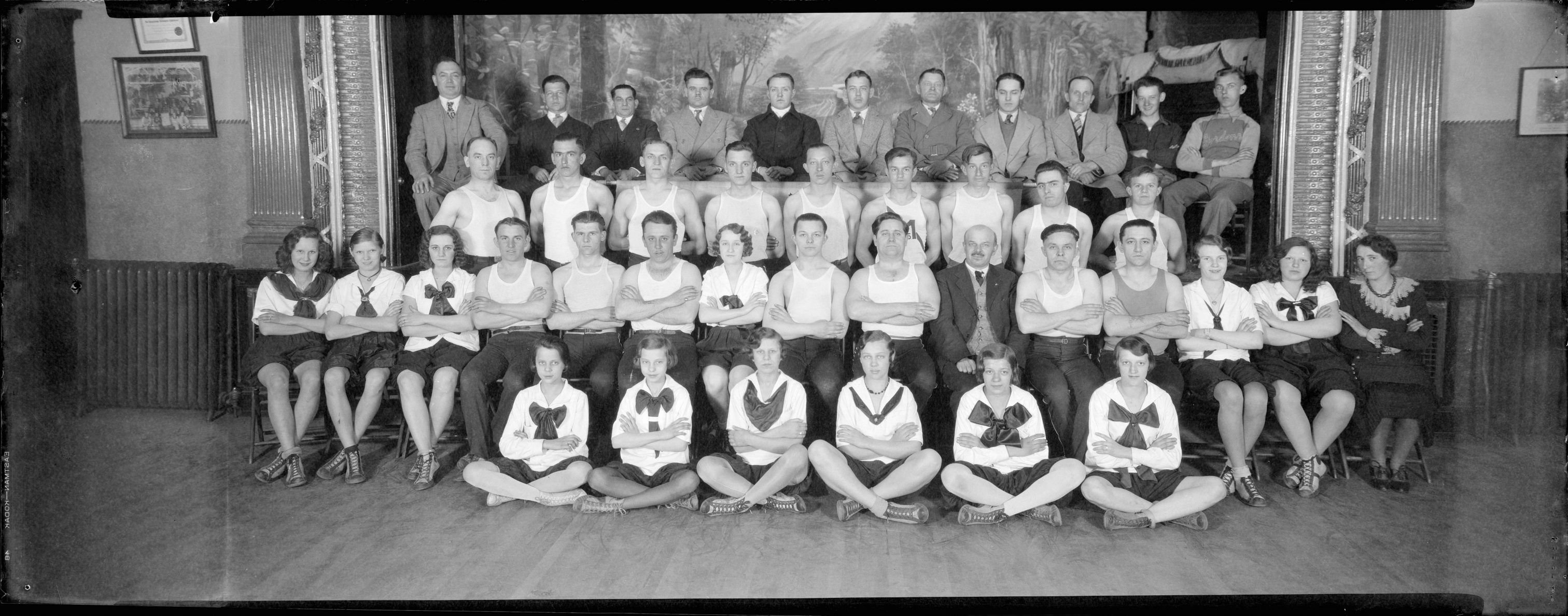The Milwaukee area’s Slovak population dates from the 1880s, when economic dislocation at home and nationalist resistance to the Magyarization policies of the Austro-Hungarian Empire prompted immigrants to come to the United States in search of jobs and a better life.[1] At the time, labor agents from American industrial plants, including southeast Wisconsin’s Patrick Cudahy meat processing operation, sought labor from many areas of southern and eastern Europe.[2] The Slovak community has been small, with about 2,000 people in the metro area claiming a birthplace in Slovakia or a mother tongue of Slovak in 1920 and some 5,000 people claiming Slovak ancestry in the 1980 census.[3]
In the 1880s, many of the first Slovaks in the Milwaukee area settled in the Second Ward. Others settled in neighborhoods in Cudahy. As they did so, the community founded two Catholic parishes, St. Stephen, at 5th and Walnut in Milwaukee in 1907, and St. Joseph, in Cudahy in 1909.[4] St. John’s Evangelical Lutheran Church also served the Slovak community in Cudahy.
There is some evidence that the Slovak community life also participated in the Czech Sokols, since the communities were similar in culture and language. In other cities, such as Philadelphia, the Sokols, which operated as a center of Czech intellectual and social life as well as gymnastics clubs, invited Slovaks into their membership. In the second decade of the twenty-first century, Milwaukee’s Sokol invites Slovaks into their organization and keeps Slovak cultural life healthy.[5] The area’s Sokol keeps alive Czech and Slovak ethnic identity through a number of functions, including gymnastics clubs, social organizations, and participation in the Holiday Folk Fair International.[6] The Wisconsin Slovak Historical Society, based in Cudahy, is dedicated to maintaining the history and culture of Slovak Americans. The organization operates the Slovak Heritage Museum in Cudahy, holds classes for people in the area to learn the Slovak language, and annually celebrates the Slovak-American Day at Croatian Park in Franklin.[7] The Tatra Slovak Dancers of Milwaukee practice traditional Slovak dances.[8] There is also a Milwaukee chapter of the Slovak Catholic Sokol, a “heritage focused” and “faith based” group founded in 1905 and intended to provide the local Slovak population with “sound financial protection and benefits.”[9]
Footnotes [+]
- ^ “Slovaks,” United States Department of State, last accessed July 12, 2012; Anton Spiesz and Dusan Caplovic, Illustrated Slovak History: A Struggle for Sovereignty in Central Europe,” edited by Ladislaus J. Balchozy, translated by Joseph J. Palus, Jr., Albert Devine, David Daniel, Michael Kopanic, and Ivan Reguli (Wauconda, IL: Bolchazy-Carducci Publishers, 2006), 90, 99-101; Marian Mark Stolarik, Immigration and Urbanization: The Slovak Experience, 1870-1918 (New York, NY: AMS Press, Inc., 1989), 6-7, 21, 26; “Slovaks in Wisconsin,” Dictionary of Wisconsin History, Wisconsin Historical Society, http://www.wisconsinhistory.org/dictionary/index.asp?action=view&term_id=11160&keyword=Slovak, last accessed July 12, 2012.
- ^ “Cudahy: Brief History,” Dictionary of Wisconsin History, Wisconsin Historical Society, http://www.wisconsinhistory.org/dictionary/index.asp?action=view&term_id=15113&keyword=Cudahy, last accessed July 12, 2012; Stolarik, Immigration and Urbanization, 6-7, 21, 26.
- ^ Data tabulated from Steven Ruggles, Katie Genadek, Ronald Goeken, Josiah Grover, and Matthew Sobek. Integrated Public Use Microdata Series: Version 6.0 [Machine-readable database]. Minneapolis: University of Minnesota, 2015.
- ^ “Cudahy: Brief History,” Dictionary of Wisconsin History, Wisconsin Historical Society, http://www.wisconsinhistory.org/dictionary/index.asp?action=view&term_id=15113&keyword=Cudahy, last accessed July 12, 2012; “Slovaks in Wisconsin,” Dictionary of Wisconsin History, Wisconsin Historical Society, http://www.wisconsinhistory.org/dictionary/index.asp?action=view&term_id=11160&keyword=Slovak, last accessed July 12, 2012; The First Catholic Slovak Union, Slovak Catholic Parishes and Institutions in the United States of America (Cleveland, OH: The Union, 1955).
- ^ Robert M. Zecker, Streetcar Parishes: Slovak Immigrants Build Their Nonlocal Communities, 1890-1945 (Selinsgrove, PA: Susquehanna University Press, 2010), 92, 197; “Sokol Sokolice Milwaukee,” Sokol Milwaukee, http://www.sokol-milwaukee.org/index.html, last accessed June 12, 2012; Anton Daniel Acker, The Czech Community of Milwaukee, 1848-1998 (Milwaukee: Milwaukee County Historical Society 2001), 15-18, 29, 33-35.
- ^ “Sokol Sokolice Milwaukee,” Sokol Milwaukee, http://www.sokol-milwaukee.org/index.html, last accessed June 12, 2012.
- ^ “Home” and “Coming Events,” The Wisconsin Slovak Historical Society, http://wisconsinslovakhistoricalsociety.org/Home_Page.html, last accessed July 12, 2012, now available at http://www.wisconsinslovakhistoricalsociety.org/, last accessed July 31, 2017.
- ^ “Tatra Slovak Dancers of Milwaukee,” Facebook, last accessed July 12, 2012.
- ^ “Home,” “Local Lodges,” and “About Us,” Slovak Catholic Sokol website, last accessed July 12, 2012.

0 Comments
Please keep your community civil. All comments must follow the Encyclopedia of Milwaukee Community rules and terms of use, and will be moderated prior to posting. Encyclopedia of Milwaukee reserves the right to use the comments we receive, in whole or in part, and to use the commenter's name and location, in any medium. See also the Copyright, Privacy, and Terms & Conditions.
Have a suggestion for a new topic? Please use the Site Contact Form.